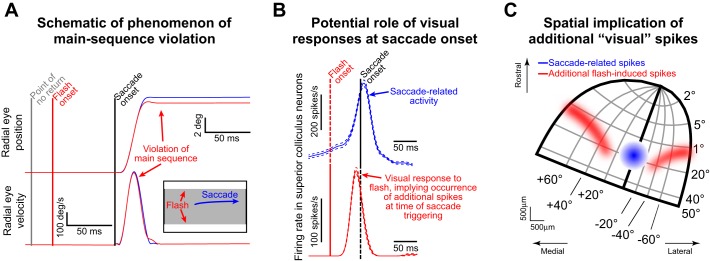Fig. 1.
The phenomenon of kinematic alteration. A: schematic of the phenomenon from a typical scenario from the literature (Buonocore et al. 2016; Reingold and Stampe 2002). Top panel shows radial eye position for 2 hypothetical saccades. In blue, the saccade is triggered without a preceding visual flash; in red, a flash consisting of 2 horizontal full-screen white bars (see inset) appears right before saccade onset and after the point of no return (gray vertical line). The saccade amplitudes are different even though peak velocity (shown in bottom panel) is minimally affected. Thus the post-flash saccade violates the main sequence relationship and has different kinematics from the no-flash movement. Note how eye velocity decelerates slightly faster for the post-flash saccade compared with the no-flash saccade, contributing to the reduced amplitude in the former movement. B: in this study, we were interested in the role of flash-induced visual responses in spatial structures such as the superior colliculus (SC). If the post-flash saccade is triggered at the time of visual response occurrence, then readout of spatial maps would have access not only to the saccade-related spikes (blue) but also to the visual spikes. C: spatially, the visual spikes would alter the center of mass of activity being read out by the oculomotor system to specify saccade end point. In this example, the SC map (Hafed and Chen 2016) would have a center of mass less eccentric than the blue saccade-related burst, which could explain the lower saccade amplitude in A. We explored the implications of this mechanism in this study.

